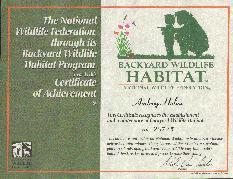 Four elements must be present for a space to be considered a habitat: food,
water, cover, and a place to raise young.
Four elements must be present for a space to be considered a habitat: food,
water, cover, and a place to raise young.
As most people who know me know, one of my house's occupants is an adorable indoor-only cat by the name of Duncan McDuff. Besides being a lazy gardener, entertaining Duncan was one of the reasons I decided to encourage wildlife to visit our yard. After all, it isn't healthy for a cat to spend the majority of his waking hours surfing the web.
Improving the diversity of our backyard has increased its visual interest, and Duncan now spends many happy hours parked in front of the doorwall, soaking up the sun and watching what we call “The Bird Show”. It also allowed me to have my yard certified as a Backyard Wildlife Habitat.
 Four elements must be present for a space to be considered a habitat: food,
water, cover, and a place to raise young.
Four elements must be present for a space to be considered a habitat: food,
water, cover, and a place to raise young.
Putting out bird feeders is an easy way to provide food. I started with one, and now have at least five in the yard at any given time. I have more feeders than I do posts, which is just as well as having spares allows me to keep a constant supply of food out for the birds while still being able to bring the feeders in for periodic sterilization. Throughout the year we stock our some of our feeders with black oil sunflower seed and others with thistle (niger). In the winter we bring out the suet feeders and occasionally add hulled peanuts to the menu.
Water was present when we began landscaping, but that was because the property came with an above-ground pool. We kept the pool for a few years, but we spent far more time on maintenance than we did swimming. As I look back, it seems like we'd either have cold, rainy weather and pure blue water, or hot, sticky weather and water with a discernible greenish tint. Then came the year we didn't didn't have time to open the pool. Rainwater collected on top of the cover and wildlife began visiting. A pair of Mallards took to paddling around, and other birds began to use it for drinking and bathing. From the muddy prints I'd see from time to time, I knew the neighborhood squirrels were visiting as well.
Convinced a pond would more bring more enjoyment, we dismantled the pool in the summer of 1996. Removing the pool did not take much time, but dealing with the hardpack underneath did. We spent the next two summers breaking up the hardpack, mixing the our heavy clay with the sand that was used as a sort of natural cushion between the hard ground and the pool liner, and wheelbarrow after wheelbarrow of compost.
When we finished digging I was eager to begin planting in the reconditioned pool bed, but fortunately my husband convinced me that we should put in the pond first. I wanted to start growing plants that would offer natural foods for our wild visitors, and plants to provide additional cover. Some cover was available, as two large trees shade our property, and we have a row of arborvitae along the northern fence. We also built a small brush pile in the southwest corner of our yard, which provides a place for moths and butterflies to evade their predators.
The last requirement for certification as a natural habitat is providing a place for the wild inhabitants to have their young. At the moment, our offerings in this regard are minimal — we have one unoccupied bird house. We plan to add others, and a bat house, as we continue to improve our little wildlife refuge.
One way we're improving is by adding native plants to our landscape. Finding Sara Stein's book Noah's Garden: Restoring the Ecology of our own Back Yards was a godsend, and the sequel, Planting Noah's Garden : Further Adventures in Backyard Ecology, has been an extraordinary source of inspiration as well as practical advice.
Noah's Garden, in turn, led to the National Wildflower Research Center, which has since changed it's name to The Lady Bird Johnson Wildflower Center. The center is an excellent resource for those interested in native plants.
The Backyard Wildlife Habitat program is administered by:
Back to Audrey's Home Page
I can be reached at aud...@mystery.com